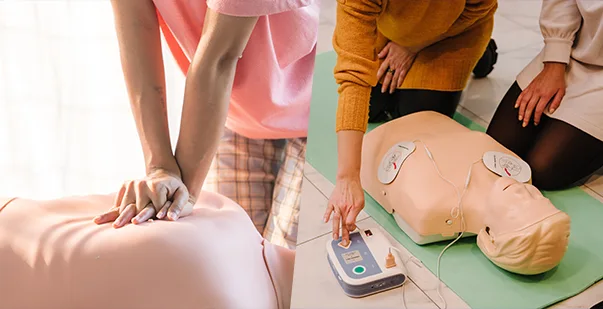Table of Contents
- Introduction
- What is CPR and AED
- When to Use an AED Vs CPR
- CPR Vs AED: Know the Differences
- Scenarios to Understand CPR and AED Differences
- Getting CPR and AED Certifications
- Final Thoughts on CPR and AED Techniques
Did you know that around 1000 people suffer from Sudden Cardiac Arrest (SCA) in the United States each day? This calls for an urgent need to recognize the signs of SCA to deliver treatment with CPR and AED techniques. A person assumes there is a cardiac emergency if someone is not breathing or remains unresponsive. Delivering CPR with an AED proves to be crucial during this time. Once again, the rescuer must know when to use each of these first aid techniques. It means they must also know the differences between CPR & AED to manage emergencies.
This article will discuss the differences between CPR and AED and other aspects of these life-saving techniques.
Master ACLS Now
Get ACLS certified with confidence
What is CPR and AED?
CPR stands for cardiopulmonary resuscitation and helps pump blood to a victim’s vital organs manually. It also involves breathing air into their lungs when their heartbeat stops. Several organs in the body begin to fail if they stop receiving blood. CPR helps sustain these organs until help arrives. That is why the technique involves giving chest compressions to keep the blood flowing inside the body. Cardiac arrest can happen anywhere at any time. That is why CPR training is a vital skill to save people in such emergencies.
Now, let us define AED in CPR, which is a machine that helps treat Sudden Cardiac Arrest (SCA). It is a life-threatening condition where the victim’s heart suddenly stops beating properly. An AED restores a normal heart rhythm by sending an electric shock to the heart of a person in cardiac arrest. Any person with little training can also use AED. These automated machines perform heart rhythm analysis to determine whether the victim needs a shock.
SCA may lead to death within minutes if a bystander does not offer help to the victim. Their survival depends on quick actions and doing CPR and AED meaning immediate intervention.
Read More: comprehensive BLS training
When to Use an AED vs CPR?
If a rescuer sees someone collapsing, they must begin CPR and use an AED immediately. Yet, they must also know when to use AED and CPR to understand which one is right for the situation. Here is a glimpse at the situations when one should use either first aid technique to save lives.
When to Use AED
Here is what a rescuer needs to do If someone has collapsed and an AED is available:
Call for Help
Check to see if the victim is breathing and has a pulse. Call for emergency help if there is no pulse and the person is not breathing. If the rescuer is alone, it is crucial to call 911 or emergency services first to make sure help is on the way. If there are other people present, one person can call 911 while the other prepares the AED. Sometimes, the patient may need both CPR and AED. In this case, one can conduct the CPR while the other prepares the AED.
Turn the Defibrillator On
Turn on the AED by following the step-by-step voice instructions. It tells how to check for breathing and a pulse in the victim. Understand how and where to place the AED pads on the victim’s bare chest.
Deliver Shocks as Needed
Stand clear to deliver the shock. Rescuers must avoid touching the victim while the AED measures their heartbeat. The machine tells the user to push a button to deliver shocks if it feels the victim needs treatment. It is necessary to make sure no one else is touching the person at that point. Saying “stand clear” loudly helps in such situations as the rescuer pushes the shock button. The AED delivers a shock only when needed.
Begin CPR
The next step is to begin CPR after delivering shocks if needed. The AED will also guide rescuers through the CPR techniques. They must repeat this process as needed until emergency medical teams take over. Effective use of CPR AED techniques improves the chances of survival in cardiac emergencies.
When to Give CPR
It is necessary to perform CPR immediately if a victim has stopped breathing or their heart has stopped beating. The process begins by manually pumping blood to the victim’s organs and providing air to their lungs. The CPR must continue until trained emergency professionals arrive for further help.
It is also crucial to know when to begin CPR on a victim in distress. It is usually administered when:
- The victim is unresponsive
- The victim’s heart has stopped beating
- The victim is not breathing
The same victim may witness insufficient breathing, which sounds like snorting, gasping, snoring, or labored breathing. The person often appears to be choking or having an involuntary gasp reflex during this time. This is called agonal breathing and needs immediate assistance with CPR.
Read More: Principles of Early Defibrillation
CPR Vs AED: Know the Differences
Both CPR and AED are crucial first aid techniques, but there are differences between them. Interested individuals must pursue courses to understand these differences better. The table below draws a comparison between AED and CPR in a better way for your understanding.
| Category | CPR (Cardiopulmonary Resuscitation) | AED (Automated External Defibrillator) |
| Purpose | Maintains blood flow and provides oxygen to vital organs. | Restores normal heart rhythm through electric shocks. |
| When to Use | When a person is unresponsive and not breathing, or has no pulse. | When a person is unresponsive and not breathing, with a suspected heart rhythm problem. |
| Procedure | Chest compressions and rescue breaths. | Apply pads to the chest and follow instructions to deliver shocks if needed. |
| Technique | Manual chest compressions at a rate of 100-120 per minute. | Automatic analysis of heart rhythm followed by shock delivery if necessary. |
| Training Required | Training in chest compressions and rescue breathing. | Training in pad placement and machine operation. |
| Equipment | No equipment needed except the rescuer’s hands. | Needs an AED device with adhesive pads. |
| Timing of Use | Provide CPR immediately if a victim is unresponsive and not breathing. | Use an AED as soon as available after starting CPR. |
| Follow-Up Actions | Continue CPR until the victim starts breathing or emergency help arrives. | Continue CPR after shock delivery if needed. |
Scenarios to Understand CPR and AED Differences
It is necessary to know which technique comes first when someone suffers sudden cardiac arrest: CPR or AED. Every situation is different, which is why it is necessary to analyze certain scenarios. These include:
Scenario 1: Sudden Cardiac Arrest in a Crowd of People
There are situations when a person witnesses someone having a sudden cardiac arrest with other people around. The rescuer may ask someone to call 9-1-1 and then tell another person to get the AED. They must make it very clear who should do each task. This involves pointing at the individuals or yelling their names. Then, the rescuer must start performing CPR immediately and should not stop until the person comes back with the AED. They must use the defibrillator as soon as it arrives.
Scenario 2: Sudden Cardiac Arrest When Alone With a Person
Sometimes, the rescuer may be alone with the victim, who suddenly suffers a cardiac arrest. In such situations, the rescuer must immediately go to fetch the AED. Standing alone, in this case, means nobody is around to help. Although CPR may be crucial here, it is important to get an AED because it helps revive the victim on time.
There is a chance that the rescuer may know where to get the AED from nearby locations. These rescuers must call emergency help immediately while going to bring the defibrillator within 3 minutes. Later, they can use the AED and then provide CPR after the first shock to the victim.
Scenario 3: Sudden Cardiac Arrest With No AED Around for Assistance
In this case, the rescuer may witness a cardiac arrest alone with the victim in a remote area. There is no AED, which means the rescuer has to do the best they can. The first step would be to call emergency help right away and put the phone on speaker mode. It must be next to the victim’s head. The rescuer must listen to the emergency helpline as they give instructions. Then, they must start performing CPR until an ambulance arrives.
Getting CPR and AED Certification
Both CPR and AED are important techniques that help save the lives of victims in emergencies. Now, the question is – how to learn these techniques? The best way is to pursue a certified course from a reputed institute. It enables individuals to learn all the knowledge and skills needed to perform the techniques correctly. Additional benefits include:
First Aid Techniques Save Lives
A person does not have to be a healthcare professional, emergency responder, or personnel to save lives in emergencies. They can do a course in CPR AED, meaning they will gain the skills and knowledge to perform life-saving techniques. The chances of a victim’s survival of cardiac arrest depend on the availability of such rescuers who can perform first aid effectively.
Anyone Can Take CPR and AED Classes
CPR and AED certification programs have no age or educational limitations. The courses are available to persons of all educational qualifications and ages. It means anyone can save the life of a cardiac arrest victim with essential skills and knowledge. The training courses are available in person and on various online platforms. Any person can take CPR/AED online classes from the comfort of their homes through computers or mobiles.
The online first aid training provides knowledge and hands-on experience. This enables the participants to obtain a certificate valid for two years.
Performance of Rescue Breathing
The skills and knowledge acquired in CPR and AED training are applicable in different areas of life. The course enables rescuers to enhance their capabilities in rescue breathing. This helps them revive victims who may have stopped breathing or responding. It can be in the case of carbon monoxide poisoning, severe asthma attacks, choking, drowning, and poisoning or overdose.
First aid involves providing oxygen to the victim’s lungs through their mouth, nose, or both. CPR and AED classes teach how to perform this procedure safely.
CPR and AED Help Prevent Brain Death
Victims who experience cardiac arrest often face the risk of suffering from permanent brain damage. This may leave them bedridden or unable to perform normal daily activities. CPR techniques performed on cardiac arrest victims with the help of AED help ensure the brain retains the required oxygen. This helps prevent the massive death of the brain cells.
Final Thoughts on CPR and AED Techniques
Cardiac arrest and heart attacks are emergencies that require fast action and quick thinking. It is best to have the right training and equipment in such situations. It means rescuers must use CPR and AED techniques to help the victims in distress. The best way to learn these techniques is to pursue training. Interested individuals can look for online certification courses or visit reputed organizations to learn more about pursuing these courses. These courses also enable the participants to know the differences between CPR and AED. It enables them to use the correct techniques to save the lives of victims.







